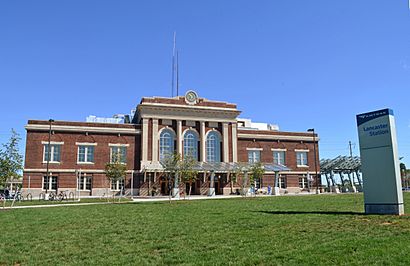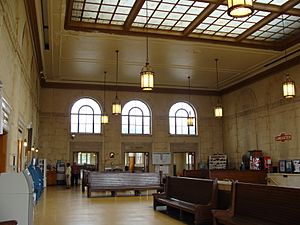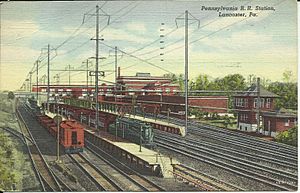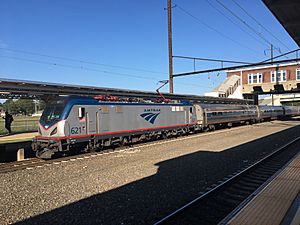Lancaster station (Pennsylvania) facts for kids
Quick facts for kids
Lancaster, PA
|
|||||||||||||||||||||||||||||||||||||
|---|---|---|---|---|---|---|---|---|---|---|---|---|---|---|---|---|---|---|---|---|---|---|---|---|---|---|---|---|---|---|---|---|---|---|---|---|---|

Lancaster station in September 2012
|
|||||||||||||||||||||||||||||||||||||
| Location | 53 East McGovern Avenue, Lancaster, Pennsylvania United States |
||||||||||||||||||||||||||||||||||||
| Coordinates | 40°3′15.71″N 76°18′27.80″W / 40.0543639°N 76.3077222°W | ||||||||||||||||||||||||||||||||||||
| Owned by | Amtrak | ||||||||||||||||||||||||||||||||||||
| Line(s) | Keystone Corridor (Main Line) | ||||||||||||||||||||||||||||||||||||
| Platforms | 2 island platforms | ||||||||||||||||||||||||||||||||||||
| Tracks | 4 | ||||||||||||||||||||||||||||||||||||
| Connections | |||||||||||||||||||||||||||||||||||||
| Construction | |||||||||||||||||||||||||||||||||||||
| Parking | 30 short-term, 50 long-term | ||||||||||||||||||||||||||||||||||||
| Disabled access | Yes | ||||||||||||||||||||||||||||||||||||
| Architectural style | Neoclassical | ||||||||||||||||||||||||||||||||||||
| Other information | |||||||||||||||||||||||||||||||||||||
| Station code | LNC | ||||||||||||||||||||||||||||||||||||
| History | |||||||||||||||||||||||||||||||||||||
| Opened | April 28, 1929 | ||||||||||||||||||||||||||||||||||||
| Electrified | January 15, 1938 | ||||||||||||||||||||||||||||||||||||
| Traffic | |||||||||||||||||||||||||||||||||||||
| Passengers (FY 2019) | 577,305 |
||||||||||||||||||||||||||||||||||||
| Services | |||||||||||||||||||||||||||||||||||||
|
|||||||||||||||||||||||||||||||||||||
|
|||||||||||||||||||||||||||||||||||||
|
U.S. Historic district
Contributing property |
|||||||||||||||||||||||||||||||||||||
| Official name: Pennsylvania Railroad Station | |||||||||||||||||||||||||||||||||||||
| Designated: | September 7, 2001 | ||||||||||||||||||||||||||||||||||||
| Part of: | Lancaster City Historic District | ||||||||||||||||||||||||||||||||||||
| Reference #: | 01000956 | ||||||||||||||||||||||||||||||||||||
The Lancaster Amtrak station is a busy train station in Lancaster, Pennsylvania. It's a key stop on the Keystone Corridor, a major rail line. This station connects people to big cities like New York City and Harrisburg.
Two main train services use this station: the Keystone Service and the Pennsylvanian. It's the second busiest Amtrak station in Pennsylvania. It's also one of the busiest in the whole United States! Many people use it to travel to and from Philadelphia.
The first train station in Lancaster opened way back in 1834. The current building was built in 1929. Today, Amtrak owns the station. It is also a historic landmark, part of the Lancaster City Historic District.
Contents
What's at the Station?
The Lancaster station is on East McGovern Avenue. It's easy to find between Queen and Duke Streets. Many trains arrive here every day.
On weekdays, the Keystone Service has 26 arrivals. Half come from Harrisburg and half from New York City. On weekends, there are 14 arrivals. The Pennsylvanian train arrives once a day from both New York City and Pittsburgh.
The station is about 49 miles (79 km) east of Harrisburg. It's 55 miles (89 km) west of 30th Street Station in Philadelphia. New York City is about 146 miles (235 km) away.
In 2019, over 577,000 passengers used this station. This makes it the second busiest in Pennsylvania. Only Philadelphia's 30th Street Station is busier. It's also the 21st busiest Amtrak station across the entire United States.
The station has a ticket office where you can buy tickets. There are also machines for quick ticket purchases. You can find vending machines and public restrooms too. Local buses, run by the Red Rose Transit Authority, stop at the station. This makes it easy to get around Lancaster.
Station History
In the early 1800s, people used canals and roads to move goods. Cities like Philadelphia wanted better ways to transport things. They worried about losing trade to New York City and Baltimore. So, Pennsylvania decided to build a big transportation network. This network would help move goods west over the Allegheny Mountains.
In 1826, the state approved building the Main Line of Public Works. This project included canals and railroads across Pennsylvania.
Early Railroads
Engineers planned a rail route called the Philadelphia and Columbia Railroad. It was supposed to go north of Lancaster. But the city asked for the route to go right through downtown.
The Philadelphia and Columbia Railroad opened in 1834. At first, horses pulled the passenger cars. Later, steam locomotives took over. The first station was likely a simple open-air platform. It was located at North Queen and East Chestnut Street.
Pennsylvania Railroad Takes Over
In 1857, the Pennsylvania Railroad bought the Main Line of Public Works. They built a new, larger station. This station was a big building supported by cast iron columns.
On April 28, 1929, the Pennsylvania Railroad opened a new rail line. This new line went around downtown Lancaster. Because of this, the old station closed. The current station building was opened north of the city.
Amtrak Era
Amtrak took over passenger rail services in 1971. Many old train routes were renamed or changed. For example, the Duquesne train became the Keystone.
From 1971 to 1979, the National Limited also served the station. It connected Lancaster to New York and Kansas City. The Broadway Limited train was stopped in 1995. It was replaced by the Three Rivers.
The Lancaster station became part of the Lancaster City Historic District in 2001. This means it's recognized as an important historic building.
Station Upgrades
For many years, the station needed repairs. In 1997, a full renovation was suggested. But it wasn't until June 2009 that work finally began. Amtrak and Lancaster County started a $12 million project.
The plans included many improvements. They added a new heating and cooling system. The ticket and waiting areas were made better. The parking lot was expanded. They also fixed up the station's inside and outside.
The renovations cost more than planned and took longer. By September 2011, costs were up by $2 million. The project was also a year behind schedule.
One funny problem was with the bus bays. They were built for smaller buses. So, the larger buses couldn't turn into them! Workers had to cut back the curbs in the parking lot. This made more space for the buses to turn.
In 2012, more work was announced. This "capstone" project focused on the station's interior. They restored the waiting area benches. Walls were painted and repaired. Lighting and accessibility were also improved. By October 2013, most of this work was finished.
Images for kids






